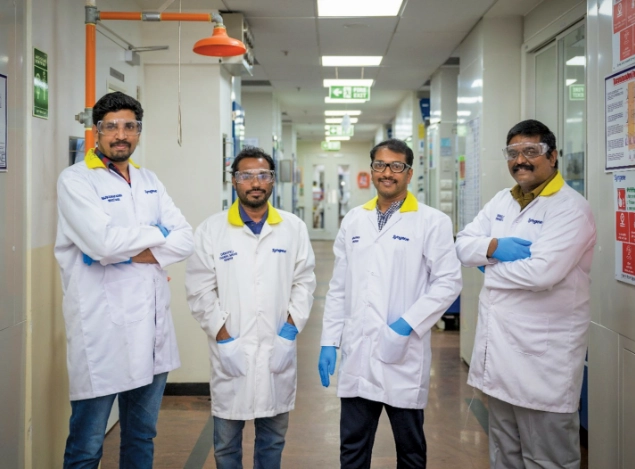

The team collaborated with a client to synthesize a drug substance (DS) for a human dermal application. The client’s existing process consisted of twelve time-consuming steps with a lower yield and less chiral purity1 of the DS. During the process of familiarization with the client to produce 25 grams of the compound, our scientists realized that technical improvements in certain steps of the synthetic scheme would benefit the client in terms of cost and duration of the entire process.
The original tech-pack developed by the client involved 12 synthetic steps. Synthesizing compounds with high enantiomeric excess (ee) – a measurement of purity used for chiral substances, is crucial. Low ee may significantly impact the biological activity of drugs. Unfortunately, one of the asymmetric reduction reactions of the client yielded a low chiral pure compound with 70% purity. A diastereomeric resolution approach was adopted to enrich the ee to >98%.
The tech-pack process yielded a clean reaction for step-5 of the process, but the reaction yield was <50%. The contaminants in the reaction contributed to the major impurities of about 25-30%. The team optimized a reaction condition to obtain <3% reaction impurities, resulting in a product with 68% yield for step-5 while maintaining >98% chiral purity as per the client’s process.
In one of the steps, the tech-pack condition required purification of the compound through the crystallization method using acetonitrile (ACN) as a solvent over four to five cycles to get a product with 98% purity. One cycle is time-consuming and takes approximately 15-16 hours and during the process familiarization project, this operation took one week. The time-consuming and labor-intensive crystallization was eliminated with an optimized reaction condition, resulting in a precise and efficient purification method essential for scale-up operations.
1 Chirality happens when a mirror image of a chemical structure of DS cannot be superimposed. These are termed as chiral impurities and may have toxic effects on patients.
As a result of these optimization studies, the team significantly enhanced the drug compound synthesis process by reducing the number of steps to ten from twelve. This boosted the overall yield to 4.2%, more than double the initial yield. These enhancements signify a substantial cost reduction for the client, exceeding 40%, alongside reduced production time, thereby empowering them to enter the market sooner.